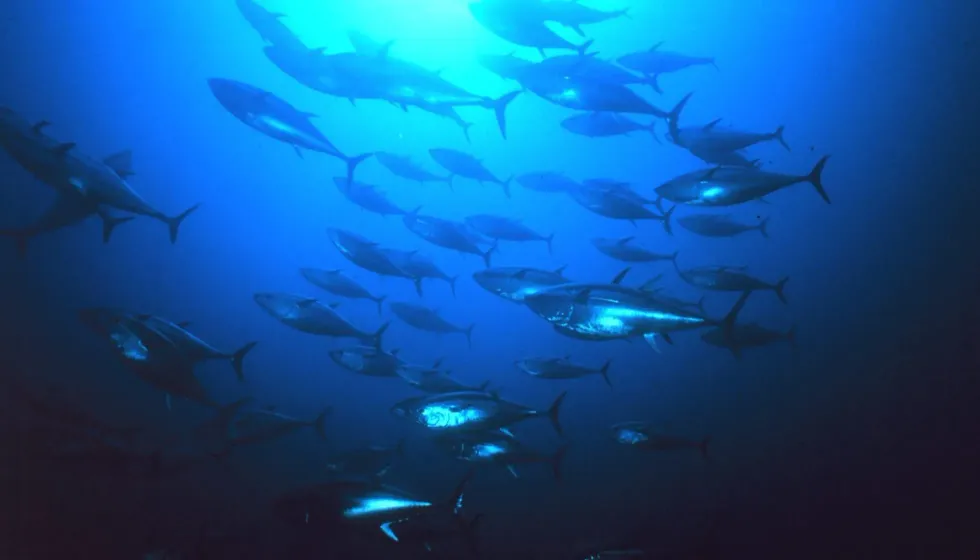Atlantic bluefin tuna (Thunnus thynnus) are a tuna species that belongs to the family Scombridae. This fish is also known as giant bluefin tuna, Pacific bluefin tuna (a relative subspecies), and also tunny.
Atlantic bluefin tuna is native to the western Atlantic Ocean and is called Western Atlantic bluefin tuna. This tuna fish is also native to the eastern Atlantic Ocean and the Mediterranean Sea. Atlantic bluefin tuna is a close relative of southern bluefin tuna and Pacific bluefin tuna.
Atlantic bluefin tuna are huge creatures with a weight of around 551 lb (250 kg). Atlantic bluefin tuna and Pacific bluefin tuna are famous fish as they are a popular food for humans.
Most famous commercial fisheries are built for selling Atlantic bluefin tuna and Pacific bluefin tuna. These fisheries are great economic centers.
Fisheries are the source of the majority of tuna population exploitation. Fisheries are needed to be restricted to save the tuna population since fisheries provide open markets for the sale of tuna. The dishes of sushi and sashimi made using bluefin tuna are considered to be of a delicious taste.
The Atlantic blue tuna has already disappeared from the Black Sea. The Atlantic bluefin tuna and the Pacific bluefin tuna are famous for their speed, size, and power.
The commercial importance of Atlantic bluefin tuna and the Pacific bluefin tuna has led to its overfishing in huge amounts. This has led to the decline of the Atlantic bluefin tuna by 72% in the eastern Atlantic and 82% in the western Atlantic over the last 40 years.
Most Atlantic bluefin tuna and Pacific bluefin tuna are captured commercially using rods, harpoons, and long lines. There is also evidence of a lot of recreational fishing of Atlantic bluefin tuna in the past.
Atlantic bluefin tuna is listed as Near Threatened in Europe and an Endangered species globally. The Pacific bluefin tuna is listed as Vulnerable by the Red List of the IUCN. The Gulf of Mexico does not allow the fishing of Western Atlantic bluefin tuna.
Continue reading for interesting facts about bluefin tuna. If you are interested in fish species, you may also want to check out milkfish and round goby facts too.
Bluefin Tuna Interesting Facts
What type of animal is a bluefin tuna?
The bluefin tuna (Thunnus thynnus) is a type of fish.
What class of animal does a bluefin tuna belong to?
The bluefin tuna (Thunnus thynnus) belongs to the class of fishes.
How many bluefin tunas are there in the world?
There are about 1 million bluefin tuna left in the world, but their populations are at threat due to overexploitation.
Where does a bluefin tuna live?
Bluefin tuna are found in the Pacific and Atlantic Oceans. Bluefin tuna (Thunnus thynnus) from the Atlantic Ocean are called Atlantic bluefin tuna, and tuna fish from the Pacific Ocean are called Pacific bluefin tuna.
Their habitat is subtropical and temperate waters. The western Atlantic bluefin tuna is found from Canada to northern Brazil. The eastern Atlantic bluefin tuna is found from Norway to the Canary Islands.
The western Atlantic bluefin tuna is found from the Gulf of Mexico to Newfoundland. This species of western Pacific bluefin tuna is also found from the Philippines to Japan.
The eastern Pacific bluefin tuna is found from Mexico to Alaska’s southern coast.
What is a bluefin tuna's habitat?
Atlantic bluefin tuna and Pacific bluefin tuna are marine fishes. They occupy both pelagic and coastal waters. They live in depths as deep as 3280 ft (1000 m). Atlantic bluefin tuna and Pacific bluefin tuna can be found in tropical, temperate, and subtropical waters.
Who do bluefin tunas live with?
Atlantic bluefin tuna and Pacific bluefin tuna live in schools and mate and hunt their prey together.
How long does a bluefin tuna live?
Tuna bluefin fish has a lifespan of 40 years. Atlantic bluefin tunas live for about 20 years while Pacific bluefin tunas live for 15 years.
How do they reproduce?
To reproduce, Atlantic bluefin tuna and Pacific bluefin tuna form spawning aggregates. Male bluefin tuna and female bluefin tuna produce sperms and eggs in synchronization.
Many bluefin tuna mate at the same time and this method is called broadcast spawning. Pacific bluefin tuna and Atlantic bluefin tuna sexually mature between the ages of four to eight years.About five to 10 million eggs are released by the Pacific bluefin tuna and the Atlantic bluefin tuna.
Bluefin tuna are generally highly migratory and migrate to the Mediterranean Sea or the Gulf of Mexico. Water temperatures suitable for spawning are 65.3-69.8 F (18.5-21C) in the Mediterranean Sea and 77-85.1 F (25-29.5 C) in the Gulf of Mexico.
What is their conservation status?
The Atlantic bluefin tuna is listed as an Endangered species at a global scale by the IUCN Red List status. In Europe, however, the Atlantic bluefin tuna is Near Threatened as specified by the Red List status of IUCN. The conservation of Atlantic tunas is highly important due to their declining population.
The Atlantic bluefin tuna population is at risk due to overfishing and is an extremely sought-after food source. They are fished in international waters because they are highly migratory.
This danger led to the formation of the agencies for the conservation of Atlantic tunas. Most Atlantic bluefin tuna is caught in the Mediterranean Sea where it is found the most.
Bluefin Tuna Fun Facts
What do bluefin tunas look like?
The Atlantic bluefin tuna body is robust and rhomboidal. They have large bodies which are torpedo-shaped. They have a large mouth and a conical head.
They have a pineal window in their heads to allow them to navigate a long range. They have gold coruscation on their body and have a dark blue and gray color. They have brightly colored yellow caudal finlets. Their pectoral fins are short in length.
A bluefin tuna is distinguished from its family by the length of its pectoral fins. The livers of Atlantic bluefin tuna have a characteristic as they are striated and covered with blood vessels. Other tunas with such short pectoral fins don’t have such blood vessels in them.
How cute are they?
The cuteness of this fish is eclipsed by their gigantic structure which makes them intimidating.
How do they communicate?
Bluefin tuna are known to be highly perceptive about their environment and can communicate through chemical and visual cues. They possess a well-developed lateral line system.
How big is a bluefin tuna?
Atlantic bluefin tuna and Pacific bluefin tuna are 10 ft (3 m) long. This species of tuna fish about six times smaller than a shark.
How fast can a bluefin tuna swim?
Bluefin tuna can swim at speeds of 20 mph (32 kph). Some bluefin tuna species can also swim at speeds as high as 45 mph (72.4 kph).
How much does a bluefin tuna weigh?
Atlantic bluefin tuna and Pacific bluefin tuna weigh about 441-551 lb (200-250 kg). They might be as heavy as 1323 lb (600 kg) in some cases.
What are the male and female names of the species?
Both species are called bluefin tuna.
What would you call a baby bluefin tuna?
A baby bluefin tuna is also called bluefin tuna.
What do they eat?
Atlantic bluefin tuna and Pacific bluefin tuna are carnivorous. This species feeds on mollusks, fish, zooplankton, echinoderms, and other marine invertebrates. The adults mainly eat herring, mackerel and bluefish. The top predators of this fish are sharks, killer whales, pilot whales and other marine mammals.
Juvenile Atlantic bluefin tuna and Pacific bluefin tuna feed on rotifers, larvae, and brine shrimp.
Are they eaten by humans?
Yes, Atlantic bluefin tuna and Pacific bluefin tuna are widely eaten by humans everywhere around the globe. These highly migratory fishes are even hunted in international waters due to their huge demand. Even though they are huge, no bluefin tuna has ever eaten a human.
Would they make a good pet?
No, tuna are very tough to pet because of their predatory nature and large size. They find it easier to be the kings of the ocean.
Did you know…
Pacific bluefin tuna facts include that they reach maturity at five years of age and they can reach speeds up to 43 mph (69 kph).
Atlantic bluefin tuna facts tell us that they are the largest tune species and can live for more than 35 years.
Bluefin tuna produce 10 million eggs in a year.
One of the bluefin tuna endangered facts is that they are declining in population all around the world. They have only a few million surviving species left, and despite conservation efforts, they are still overfished.
How to catch and eat bluefin tuna?
The bluefin tuna fishing season is a long affair that lasts from June to November. However, the best fishing months are August and September.
Atlantic bluefin tuna and Pacific bluefin tuna are highly expensive. One reason for this is the supply with respect to the corresponding demand. Bluefin tuna is in great demand and so it is expensive. Prices are also high to regulate the fishing of bluefin tuna in eastern countries like Japan.
Why are bluefin tunas endangered?
The population of bluefin tunas is declining and they are an endangered species due to their high commercial value and great taste. They are overfished in many areas due to this reason. There are 5-10 million bluefin tunas left in the world currently.
Here at Kidadl, we have carefully created lots of interesting family-friendly animal facts for everyone to discover! For more relatable content, check out these clown rasbora facts and pigfish facts pages.
You can even occupy yourself at home by coloring in one of our free printable Bluefin Tuna coloring pages.










